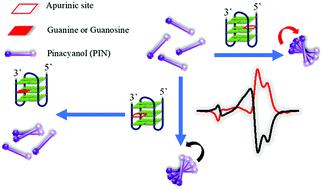Our official English website, www.x-mol.net, welcomes your
feedback! (Note: you will need to create a separate account there.)
G-quadruplex apurinic site-programmed chiral cyanine assemblies for specifically recognizing guanosine and guanine
Analyst ( IF 3.6 ) Pub Date : 2021-08-06 , DOI: 10.1039/d1an01110c Chenxiao Yan 1 , Yun Chang 1 , Heng Gao 1 , Qingqing Zhang 1 , Shuzhen Peng 1 , Dandan Wang 1 , Xiaoshun Zhou 1 , Yong Shao 1
Analyst ( IF 3.6 ) Pub Date : 2021-08-06 , DOI: 10.1039/d1an01110c Chenxiao Yan 1 , Yun Chang 1 , Heng Gao 1 , Qingqing Zhang 1 , Shuzhen Peng 1 , Dandan Wang 1 , Xiaoshun Zhou 1 , Yong Shao 1
Affiliation

|
DNA-tuned dye assemblies have received considerable attention toward developing various devices. Owing to easy conformation implementation, G-quadruplexes (G4s) have been extensively used as initiators to grow dye assemblies with controllable chiralities. However, programmed chirality regulation of dye assemblies for a given G4 sequence has not been realized in a straightforward manner. In this work, we replaced a middle guanine in the G-tracts of a human telomeric G4 with an apurinic site (AP site) to meet the programmed dye assemblies. Although all of the AP site replacements altered the G4 conformation from the hybrid to the antiparallel folding, the handedness of pinacyanol (PIN) assemblies grown on the AP site-containing G4 was programmably regulated. The G4 with the AP site at the 5′-most G-tract grew right-handed assemblies, while that with the AP site at the 3′-most G-tract grew left-handed assemblies. The handedness of assemblies almost totally mirrored each other within 450–700 nm. Interestingly, we found that the AP site provided a specific binding site for guanosine and guanine, and this binding event sensitively broke the chiral assemblies. Thus, dye assembly-based sensors can be easily established based on the chiral responses with a high selectivity and sensitivity. Our work first demonstrates the AP site programmed chirality regulation of G4-grown dye assemblies and will find wide application in chiral devices.
中文翻译:

G-四链体无嘌呤位点编程的手性花青组装体,用于特异性识别鸟苷和鸟嘌呤
DNA 调谐染料组件在开发各种设备方面受到了相当大的关注。由于构象易于实现,G-四链体(G4s)已被广泛用作引发剂来生长具有可控手性的染料组件。然而,尚未以直接的方式实现给定 G4 序列染料组件的程序化手性调节。在这项工作中,我们用无嘌呤位点(AP 位点)替换了人类端粒 G4 的 G 束中的中间鸟嘌呤,以满足程序化的染料组装。尽管所有 AP 位点替换都将 G4 构象从杂合体改变为反平行折叠,但在包含 AP 位点的 G4 上生长的频氰醇 (PIN) 组件的旋向性受到可编程调节。AP 位点位于 G 道最 5' 处的 G4 生长右手组件,而在 3' 最 G 道上的 AP 位点生长的是左手组件。组件的旋向性在 450-700 nm 内几乎完全相互反映。有趣的是,我们发现 AP 位点为鸟苷和鸟嘌呤提供了一个特异性结合位点,这种结合事件敏感地破坏了手性组装。因此,可以基于具有高选择性和灵敏度的手性响应轻松建立基于染料组装的传感器。我们的工作首先展示了 G4 生长染料组件的 AP 位点程序手性调节,并将在手性器件中得到广泛应用。这个结合事件敏感地破坏了手性组装。因此,可以基于具有高选择性和灵敏度的手性响应轻松建立基于染料组装的传感器。我们的工作首先展示了 G4 生长染料组件的 AP 位点程序手性调节,并将在手性器件中得到广泛应用。这个结合事件敏感地破坏了手性组装。因此,可以基于具有高选择性和灵敏度的手性响应轻松建立基于染料组装的传感器。我们的工作首先展示了 G4 生长染料组件的 AP 位点程序手性调节,并将在手性器件中得到广泛应用。
更新日期:2021-09-01
中文翻译:

G-四链体无嘌呤位点编程的手性花青组装体,用于特异性识别鸟苷和鸟嘌呤
DNA 调谐染料组件在开发各种设备方面受到了相当大的关注。由于构象易于实现,G-四链体(G4s)已被广泛用作引发剂来生长具有可控手性的染料组件。然而,尚未以直接的方式实现给定 G4 序列染料组件的程序化手性调节。在这项工作中,我们用无嘌呤位点(AP 位点)替换了人类端粒 G4 的 G 束中的中间鸟嘌呤,以满足程序化的染料组装。尽管所有 AP 位点替换都将 G4 构象从杂合体改变为反平行折叠,但在包含 AP 位点的 G4 上生长的频氰醇 (PIN) 组件的旋向性受到可编程调节。AP 位点位于 G 道最 5' 处的 G4 生长右手组件,而在 3' 最 G 道上的 AP 位点生长的是左手组件。组件的旋向性在 450-700 nm 内几乎完全相互反映。有趣的是,我们发现 AP 位点为鸟苷和鸟嘌呤提供了一个特异性结合位点,这种结合事件敏感地破坏了手性组装。因此,可以基于具有高选择性和灵敏度的手性响应轻松建立基于染料组装的传感器。我们的工作首先展示了 G4 生长染料组件的 AP 位点程序手性调节,并将在手性器件中得到广泛应用。这个结合事件敏感地破坏了手性组装。因此,可以基于具有高选择性和灵敏度的手性响应轻松建立基于染料组装的传感器。我们的工作首先展示了 G4 生长染料组件的 AP 位点程序手性调节,并将在手性器件中得到广泛应用。这个结合事件敏感地破坏了手性组装。因此,可以基于具有高选择性和灵敏度的手性响应轻松建立基于染料组装的传感器。我们的工作首先展示了 G4 生长染料组件的 AP 位点程序手性调节,并将在手性器件中得到广泛应用。











































 京公网安备 11010802027423号
京公网安备 11010802027423号